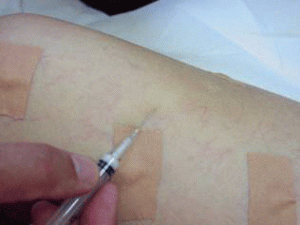[et_pb_section bb_built=”1″ fullwidth=”off” specialty=”off” _builder_version=”3.0.101″ border_radii=”on|20px|20px|20px|20px” border_width_all=”5px” border_color_all=”#0c71c3″ border_style_all=”outset” border_width_right=”0px” border_width_bottom=”0px” box_shadow_style=”preset3″ custom_padding=”|30px||”][et_pb_row _builder_version=”3.0.101″ custom_padding=”|||30px”][et_pb_column type=”1_2″][et_pb_divider _builder_version=”3.0.101″ /][et_pb_text _builder_version=”3.0.101″ background_layout=”light” header_text_color=”#0c71c3″ text_text_color=”#0c71c3″ header_4_text_color=”#0c71c3″ header_5_text_color=”#af1616″ header_4_font=”|700|||||||” header_5_font=”|700|||||||” header_4_font_size=”23px”]
Sclerotherapy
Sclerotherapy is a technique used since the ancient time to take care of the phlebological illnesses
of the lower limbs: varices and capillaries.
Truly, the sclerosing are also used in other body districts (haemorrhoids, oesophageal varices and
other) but right now we will only deal with lower limbs.
Practically a particular liquid is injected in the vein or in the capillary that irritates, in a controlled
way, the inside wall of the vessel, the intima, provoking the closure.

In this way the venous ecstasies go away.
The phlebological Italian school has already
defined the indications for all phlebological
therapies.
The sclerosing are surely suitable for all the
telangiectasias and in particular for the big, very
branched and blue capillaries.
They are less suitable for the red and thin
capillaries. For those, both for face (couperose)
and for legs, the laser is very efficient. Attention!
Not all lasers, but only some types with a welldefined
wavelength. Getting back at the sclerotherapy, we need to underline that there are many
types of liquids that can be used: stronger if we deal with major diameter, and more and more
delicate for veins with minor calibre. And, lately, a new technique of sclerotherapy has been made
up through the so called “mousse”: practically the same liquid that was used before, now is treated
in a particular way obtaining in the end the more efficient mousse with very reduces dosages, as
you can see in the picture. Normally, I do not bandage when I treat capillaries, but I just put a
little plaster that prevents the bleeding after the injection and it allows a sort of little aimed
compression. When bandages are not used is however warmly advisable (practically it is
mandatory) the use of an elastic sock, variable in compression that allows an aimed compression,
well supported by the patient. Varicose veins, the bigger ones also, are susceptible of sclerosing
therapy, too. But which ones?? I personally prefer to keep the surgical operations, as
saphenectomy or outpatient phlebotomy, for varices of the big and small saphena also associated
to dilated collaterals. If instead the patient has not a surgical indication, then I use the sclerosing
in an extensive way. We need to remember that the capillaries do not go away as if we used an
eraser: before they are a little bit irritated, then they get brown, green, and yellow and in the end
they go away as haematomas do. Sometime a strong staining can remain for few months. It will
go away.. you need to be patient. Sometime the skin, in the spot’s injection, can become irritated
giving place to the so-called “slough from sclerotherapy”. They are very rare, and usually, they do
not leave any evident scars. However, if the technique is correct, those collateral effects remain
rare. It is fundamental to know that the varicose disease is a chronic disease. Every therapy will
never be able to be definitive, but in every case it will always need little controls during the time.
Beside it will be always useful to associate prevention and a deep care to all these therapies in
order to reduce the venous insufficiency.
Indications:
Varices of saphenic collateral.
Varicose residues after a surgical operation.
Capillaries.
[/et_pb_text][/et_pb_column][et_pb_column type=”1_2″][et_pb_divider _builder_version=”3.0.101″ color=”#0c71c3″ divider_weight=”2″ max_width=”33%” module_alignment=”center” /][et_pb_divider _builder_version=”3.0.101″ color=”#0c71c3″ divider_weight=”2″ max_width=”33%” module_alignment=”center” /][et_pb_text _builder_version=”3.0.101″ background_layout=”light” header_text_color=”#0c71c3″ text_text_color=”#0c71c3″ header_4_text_color=”#0c71c3″ header_5_text_color=”#af1616″ header_4_font=”|700|||||||” header_5_font=”|700|||||||” header_4_font_size=”23px”]
Informed Consent –Sclerotherapy for veins and capillaries
[/et_pb_text][et_pb_button _builder_version=”3.0.101″ button_text=”Download PDF” button_url=”https://www.docredaelli.com/wp-content/uploads/2018/04/Microsoft-Word-Consenso-informato-scleroterapia.doc.pdf” url_new_window=”off” button_alignment=”center” background_layout=”light” custom_button=”on” button_icon_placement=”right” button_text_color=”#ffffff” button_border_color=”#0c71c3″ button_bg_color=”#0c71c3″ button_font=”|700|||||||” button_border_radius=”6″ /][et_pb_divider _builder_version=”3.0.101″ show_divider=”on” color=”#0c71c3″ divider_weight=”2″ max_width=”33%” module_alignment=”center” /][/et_pb_column][/et_pb_row][/et_pb_section]